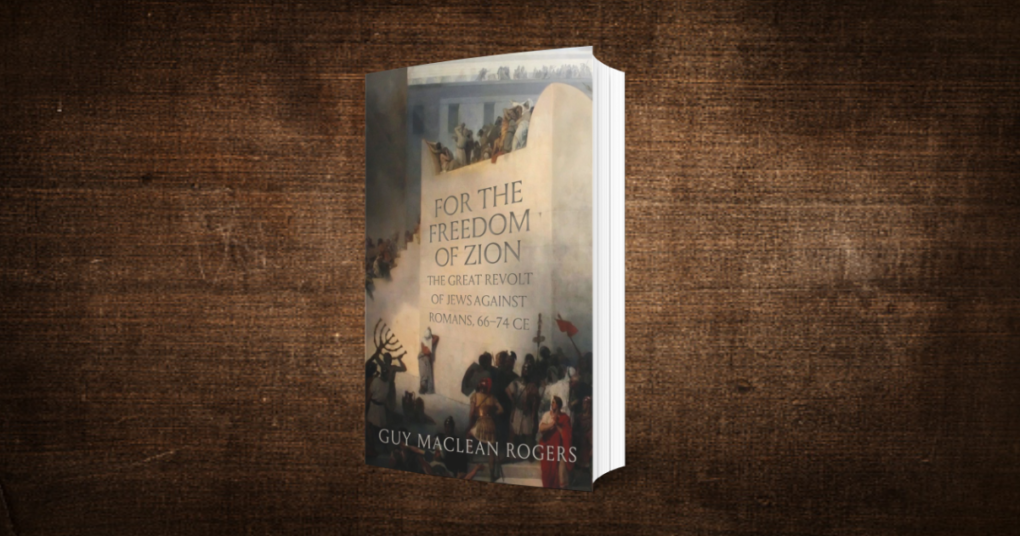For the Freedom of Zion: The Great Revolt of Jews against Romans, 66-74 CE
Guy MacLean Rogers
Yale University Press
2022
721 pages
The destruction of the Temple in Jerusalem by the Romans in AD 70, has a central place in Jewish consciousness. Many Jews still commemorate it with a day of fasting every year on Tisha B’Av. The loss of the Temple dramatically reshaped Judaism by greatly accelerating trends that were already visible. Once the Temple sacrifices ceased, the priestly caste lost its influence, and authority in religious matters shifted entirely towards the scholarly rabbi. And the Jews of Palestine were scattered across the Roman Empire, as far west as Spain and as far north as the banks of the Rhine.
One of the great strengths of Guy MacLean Rogers’s richly detailed account of the Jewish Revolt against Rome is his attention to its antecedents, going back to the reign of the ruthless King Herod (d. 4 BC), who rebuilt the Second Temple on a massive scale, transforming it into one of the most impressive monuments of its day. Benefiting from inherited wealth, lucrative taxation and the confiscation of the assets of the elite, he left an indelible mark on the region. And yet Rogers shows how in succeeding decades, waves of violence – not just between Jews and Greeks but between Jews and Samaritans, and, even more calamitously, between Jews and Jews – generated local revolts and exasperated a succession of not very competent Roman governors (including Pontius Pilate), who often made things far worse.
The origins of the revolt lay in the troubled relationship between the Jews and the imperial court in Rome. Gaius Caligula, who wanted to erect a statue of himself as Jupiter in the Temple, enraged Jewish opinion. But for Rogers the catalyst was Nero’s impossibly ambitious plan to rebuild Rome after the great fire of AD 64. The cost was beyond his means, but he knew that there was plenty of gold and silver in the Temple treasury. The governor, Florus, “wanted to raise money, not war”. But a confrontation in Caesarea between a Greek blocking the way to a synagogue and the local Jews lit a fire that spread to Jerusalem, where Florus’s troops indiscriminately killed 3,600 men, women and children.
The response was an uprising whose ideology was based on the dream of restoring Jewish sovereignty, and was expressed through coinage inscribed in archaic script as a reminder that the Jews had won their freedom from Pharaoh many centuries earlier; its design is replicated on modern Israeli currency. The indiscriminate massacres that took place cost hundreds of thousands of lives, although the main source, the priest Josephus, a rebel commander who defected to the Romans, may have inflated his figures by as much as a factor of 10. His view was that God was backing the Romans as punishment for the lethal divisions among the Jews.
Rogers describes the fall of Jerusalem and the destruction of the Temple in vivid detail. The Roman commander (and future emperor) Titus emerges better than many will expect. Josephus insisted that Titus never wanted the Temple to be destroyed, although the Romans may have wished to abolish the Temple sacrifices. Titus forbade attacks on Jews in other parts of the region. He did, though, take part in a massive triumphal procession in Rome, and the Colosseum was built with Jewish slave labour.
Rogers says little about the religious, social and cultural background of Roman Palestine. Rather, he focuses on the revolt and its ruthless suppression. He shows why Rome willingly launched the most massive campaign of the time against what might seem a small corner of its empire. Rogers’s command of issues such as supplies needed by a Roman army on the march is impressive. Through his close analysis of the war, making extensive critical use of Josephus’s works, he raises and resolves important questions about the nature of a revolt whose ripples can still be felt in our own time.
About the Author: David Abulafia
David Abulafia is author of The Boundless Sea: A Human History of the Oceans which won the Wolfson History Prize in 2020. He is Emeritus Professor of Mediterranean History at Cambridge University. This article has been reprinted from the Catholic Herald.

